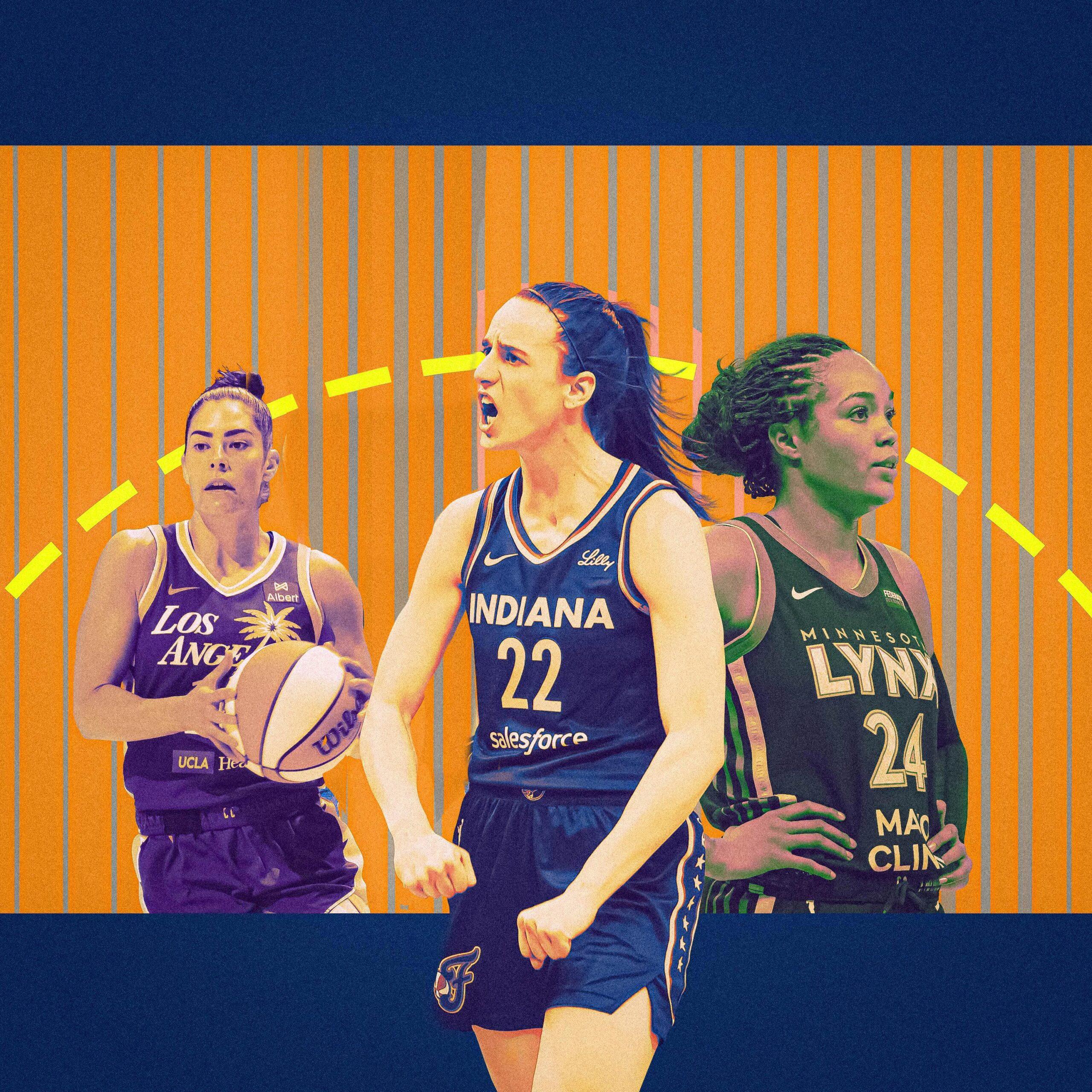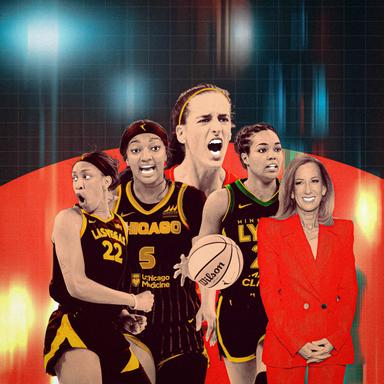
The most anticipated WNBA season of all time is already delivering. After a frenzy of player movement and seven head coaching changes this summer, some of our offseason questions are being answered quickly: The New York Liberty and Minnesota Lynx remain in a tier above everyone else, Aliyah Boston is making the third-year leap, and Smesko-ball looks just as wonky as we’d all envisioned. But the first stretch of the season has also created new questions: How will the Indiana Fever adapt to life without Caitlin Clark, who suffered a quad injury over the weekend? Did the Chicago Sky mortgage their future on a lottery-bound season? Are the Las Vegas Aces underdogs again? Is the Rookie of the Year … Kiki Iriafen? Without further ado, here are 11 observations on the first 11 days of the WNBA season.
1. Now we know why Caitlin Clark was struggling.
In Thursday’s game against the Atlanta Dream, Clark went a whole game without making a 3 for the first time since her sophomore season at Iowa. The inevitability of Clark’s logo bombs has made her appointment viewing for the past three years while powering women’s basketball to new heights. But she had an 0-5 outing in that Atlanta Dream game and has missed 14 consecutive triples across three games (two against the Dream and one against the Liberty). I spent more time than I’d care to admit watching Clark’s 3-point misses, looking for a lesson in the anomaly.
On Monday, the Indiana Fever provided an explanation. After their loss to the Liberty on Saturday, Clark got an MRI revealing a strained quad. She will be reevaluated in two weeks. That quad, by the way, is the one she has to put her weight on to go to the left when she shoots her patented stepback 3, a shot the Liberty had—in hindsight—a suspiciously easy time getting her to lean away from.
The common thread in Clark’s first four misses, beyond New York’s switchy, mobile forwards? All of them were going to the right.
The Fever are taking what Stephanie White calls a "long-game approach" to this injury.
“It's making sure that we address this in a way that doesn't affect long-term, that we take care of it, don't over-push, don't overexert,” White told reporters. “Sometimes, great players don't tell you when they're hurting. I'm glad that she did because we need to nip this in the bud."
While White said that she didn’t know the grade of the strain, quad injuries range greatly in severity, which is likely why the team is reevaluating her in two weeks, as opposed to predicting when Clark will be ready to return. A two-week timeline suggests that the strain is somewhere from mild to moderate. But because of the quad’s connection to more serious knee injuries and the role it plays in fortifying Clark’s oft-repeated signature shot, it’s nothing to be played with.
In their four games, the Fever have played a total of just 20 minutes without Clark and outscored opponents by a whopping one (1) point. In the absence of its engine, Indiana will likely play a slower, more deliberate, and more defensively oriented half-court game. Luckily, the Fever have the personnel for it. This is an opportunity to incorporate pull-up artist DeWanna Bonner, who came off the bench against the Liberty and has been relegated to forgotten spot-up shooter, into the offense. Sophie Cunningham is one of the better off-dribble shooters in the league. In the past two seasons, Kelsey Mitchell was an All-Star, averaging 18.7 points on 46/40/83 splits. It’s time to surround Natasha Howard and Boston with shooters and let their two-woman high-low game cook.
On that note …
2. Aliyah Boston is making the leap at the perfect time.
On the bright side for the Fever, Boston is averaging career highs in points (18.5), rebounds (10.8), field goal percentage (60.8), and blocks (two) to start the year.
Nineteen of her 31 buckets, though, have been assisted by Clark. But if you dig into the tape, you’ll also notice an uptick in self-creation after the initial feed:
The game has clearly slowed down for the third-year big, whose patient pump fakes, well-timed bumps, decisive dribble moves, and increased range should translate to a more individualized role.
Peep these dribble handoff fakes, which could also be executed alongside shooters and scorers like Mitchell, Bonner, Cunningham, and Lexie Hull:
Boston has also served as a release valve for Clark in the backcourt, dribbling the ball up the floor in transition and using her combination of size, strength, and quickness to get to the cup. Her approach is reminiscent of Alyssa Thomas, whom White drew up plays for last season with the Connecticut Sun:
Though Boston’s assists are down this season—White has asked her to be more selfish—she is, like Thomas, among the best playmaking bigs in the WNBA. Without Clark, Indiana’s creation talent is tilted toward the frontcourt and its spacing toward the backcourt. With that in mind, I’d love to see White get creative with some inverted pick-and-rolls allowing Bonner, Howard, and Boston to put pressure on the rim and kick out to shooters.
Last week, No Cap Space’s Chauny Powell suggested that Boston could notch her first triple-double this season. With Clark out, that could happen sooner rather than later.
3. Kelsey Plum is always a good bet.
Seeing Kelsey Plum up close is a study in desire. Her chiseled frame is evidence of the work that goes into squeezing every ounce of bounce, strength, and stamina out of her 5-foot-8 frame, to ensure her body can keep up with her mind’s resolve.
As Cheryl Reeve put it after the Lynx escaped Los Angeles with a victory last week, “She’s relentless. She’s probably the most conditioned athlete in the league.”
Now that the 30-year-old has finally been given the keys to a franchise, she's posting the best stats of her career, averaging career highs in points (24.8), assists (5.6), free throw attempts (6.8), made 3s (3.8), and steals (2.4).
Plum thought that the Sparks would be a better spot than the Aces for the next step in her evolution, so she set her sights on building something new in SoCal, where she grew up. So far, she’s been cashing in on the bet she made on herself. What remains to be seen is whether the Sparks, who are hoping that Plum helps them catch up to modern organizational standards, can hold up their end of the bargain.
Plum has willed the Sparks, who are now missing Rae Burrell, Rickea Jackson, and Cameron Brink, to victories over the Sky and Valkyrie (and almost the Mercury), giving them some cushion before the team is fully healthy. But every time she lands hard after driving to the rim, I find myself wondering—as I do with any determined, fearless, undersized guard—how long she can sustain this. But the fact is that just about everything Plum has done to this point has been against the odds, so why bother doubting her now?
4. Kiki Iriafen is just scratching the surface.
Sonia Citron has stolen headlines with her hot shooting, patient drives, and lockdown defense, but I want to give some shine to the Washington Mystics’ other newcomer who’s making a run for Rookie of the Year.
After navigating a clogged, JuJu-centric USC team, Kiki Iriafen is thriving in the space, pace, and freedom afforded to her by the Mystics.
Her off-and-on senior year, when her mid-post attacks were confined and she had to defend out on the perimeter, hurt her draft stock but stretched her capabilities, allowing her to prepare for a smooth transition to the WNBA.
The question for Iriafen—a 6-foot-3 big who struggled as a rim protector—was whether her game would translate to the pros. Was she agile enough to punish other teams around the perimeter? Was she big enough to dominate the paint? With the Mystics, whose new coach, Sydney Johnson, doesn’t want to put his players in a box, all of those perceived limitations have become possibilities.
On Sunday, Iriafen became the second player in WNBA history to post four double-doubles in her first five games. Her quickness and motor give her a knack for rebounding, and she can handle the ball in transition.
Iriafen isn’t the world’s best playmaker, but she’s incredibly detail oriented and processes information quickly while displaying a mastery of the fundamentals: screening, rolling hard and fast, shooting midrange jumpers, sealing off opponents, and finishing layups. Her ability to do multiple things at a high level makes unpredictable to cover. On top of that, she’s athletic, fearless, fluid, and rangy.
If Iriafen puts together everything she’s capable of doing, she could be the next great power forward in a lineage that includes legends like A’ja, Phee, Stewie, and Candace Parker.
5. Lauren Betts, you are a Minnesota Lynx.
The Sky, who were blown out by a combined 60 points in their first two games and dropped to 0-3 on Sunday, were already having a bad start to the season. But it gets even more painful when you factor in the elite play of Citron, whom the Mystics took with the no. 3 pick that Chicago traded to them for Ariel Atkins.
Citron and Atkins are both 3-and-D wings, but Atkins is 28 and will be a free agent next year, while Citron is just 21 and on the same developmental timeline as Angel Reese and Kamilla Cardoso. She’s also on a rookie-scale deal that expires in 2028 and will become even more valuable if the cap spikes after the new CBA.
But let’s shift our focus to a different potential draft disaster, one that threatens to upend not only the falling Sky but also the rest of the league: The 0-3 Sky owe an unprotected 2026 first-round draft pick to the Lynx. (Hello, Lauren Betts.)
At first, the parties agreed to a pick swap so that Chicago could move up a spot in the 2024 draft to nab Reese. Fair enough. But then, ahead of this year’s draft, Chicago agreed to convert the swap into an outright trade in exchange for the no. 11 pick, which they used to take Hailey Van Lith.
In hindsight, considering that the pick swap likely would have conveyed to the Lynx anyway, that second deal to nab Van Lith was smart. But it also suggests that the Citron-Atkins trade (and Chicago’s general efforts to move from the penthouse to the ground floor in a season) was motivated by the fact that the Sky don’t have their pick, and it looks like that’s backfiring.
So much of the Sky’s modus operandi this season—cutting Chennedy Carter loose, firing Teresa Weatherspoon and hiring Tyler Marsh, and surrounding their rookies with vets, including Atkins—was in service of professionalizing the organization’s culture ahead of free agency in 2026. But now I don’t really know what I’m watching when I’m watching Chicago. It certainly doesn’t look like a solid free agency pitch.
6. The Las Vegas Aces might have found a few answers.
The Aces, who believed that their woes last year were related to mental and physical fatigue more than personnel, largely ran back the same roster and system this season, outside of trading Plum for Jewell Loyd.
Both are star guards on offense, but the similarities end there. Plum is a relentless shoot, drive, or kick attacker, while Loyd is a pick-and-roll impresario with a lethal midrange game. The Aces shot the most corner 3s in the WNBA last year, and losing Plum left a gaping hole in their spacing. On last week’s episode of The Ringer WNBA Show, I expressed concern that the Aces were trying to pigeonhole Loyd, who shot six corner 3s last year, into a mismatched role.
She, of course, responded with a game-winning corner 3, set up by A’ja Wilson:
Let this serve as a reminder that early in the season, everything—systems, personnel, lineups, schemes, percentages—is highly malleable. The Aces are still figuring things out and have experienced a few blowouts along the way. I’m keeping that in mind now because, in an ugly loss to the Storm, a silver lining may have emerged in the form of rookie Elizabeth Kitley, a lottery-level talent who fell in the draft due to injuries and missed all of last season.
She entered the game and immediately became a balm for what’s been ailing the Aces: the lack of a meaningful frontcourt presence flanking Wilson:
In a manner reminiscent of the mismatch advantages that Dearica Hamby and Candace Parker (before she got hurt) gave the Aces’ championship rosters, Kitley entered the game and calmly nailed a turnaround fadeaway, stepped through Dominique Malonga, and created second-chance opportunities.
Unlocking Kitley won’t solve every issue the Aces are facing, but it gives them a lot more to work with.
Related …
7. “Aces vs. Everybody” is back.
Coming off two Las Vegas titles, “Aces vs. Everybody” became an empty galvanizing cry last season. Like Jordan after his first first three-peat, Wilson—who broke the WNBA’s all-time season scoring record and cracked 1,000 points last season—had to scrape the bottom of the barrel in search of perceived slights.
The team as a whole was decorated with All-Stars and Olympians, and off the court, the Las Vegas Tourism Board was being investigated for offering the players sponsorships that potentially violated the CBA. Throw in Hamby’s lawsuit looming over the team (which hasn’t gone away yet), and the Aces were giving off tremendous evil empire vibes.
This year, though? Nobody believes in them, for real. They’ve lost their star guard, two key assistant coaches, and a ton of depth.
Wilson, whose playmaking continues to improve, remains the best player in the world (though Napheesa Collier may have something to say about that by the end of the year), but she and the Aces are flying under the radar for now, usurped by teams like the Fever and Mercury, who made splashier moves this summer.
That said, the true marker of an underdog is acting like one, on and off the court. As of now, they aren’t there yet. Las Vegas hasn’t put up the requisite effort on the defensive end, and Becky Hammon’s schemes haven’t illustrated an appropriate understanding that the league as a whole has leveled up since the Aces’ glory days. There’s plenty to doubt about this team, which could give the Aces all the ammunition they need.
8. The Storm is coming.
After missing training camp, Dominique Malonga, the most intriguing player in this year’s draft, has finally gotten some consistent run, finishing the Storm’s blowout win against the Aces with eight points and five rebounds.
The no. 2 pick looked every bit her 19 years, biting excitedly on pump fakes but also offering mesmerizing glimmers of the future, like high-handed contests and unblockable high-low buckets:
She even paid the Kevin Durant tax on her first long jumper—a 22-footer with a toe on the line. At the end of the third quarter, Gabby Williams tried to throw her an alley-oop from half court, because whose imagination wouldn’t be stimulated by this 6-foot-6 French wonder?
Meanwhile, the Storm look organized, zippy, and synchronized on offense. Skylar Diggins, initiating in the lower third and serving picture-perfect pocket passes to Ezi Magbegor and Nneka Ogwumike, is averaging a career-high 20 points and 10 rebounds. Take this play, in which the Storm use Diggins on the high post in a horns set to offset her lack of 3-point spacing and create space for Ezi and Nneka:
Or this gorgeous dish from Ogwumike—one of her many corner finds this season—to Williams, who is shooting 50 percent from beyond the arc:
The Storm were already primed to be a great defensive team. Few defenders can gobble up Wilson like Magbegor (my early candidate for Defensive Player of the Year) did here:
If their chemistry, unselfishness, execution, and shooting hold up on offense, Seattle could be scary, playing high-level basketball with a phenom waiting in the wings.
9. Jessica Shepard is Minnesota’s X factor.
The Lynx are built in the image of Collier, whose pliability, skill, stamina, and quickness make her one of the most versatile players in the WNBA. After last year’s heartbreaking Finals loss, she opened the season on a tear, leading the WNBA in points (29.5) while shooting at a ludicrous 56/54/93.5 clip.
The problem? Not everyone can keep up—as last year’s midseason acquisition Myisha Hines-Allen learned. The Lynx are like a Ferrari. Adding new pieces is often difficult and expensive.
Which is why the return of Jessica Shepard, who spent last season overseas, has been a panacea for a team that’s lost key frontcourt pieces in Cecilia Zandalasini and Dorka Juhasz.
She also brings a mixture of talents to the Lynx's frontcourt that they were lacking last season.
Shepard is one of the rare players who fits the criteria to bolster Minnesota’s rotation. She’s a strong, versatile defender who can switch onto the perimeter and a quick, willing playmaker who brings a dynamic element they were missing last year. In the post, she is strong, balanced, and savvy, spinning off and through defenders to find favorable rim angles, giving a new look to Minnesota, who finished last in the percentage of points scored at the rim last season.
Speaking of critical players …
10. Jonquel Jones is New York’s X factor.
Jones is averaging 18 points, 9.7 rebounds, and 3.3 assists on 57/50/77 splits in 29.3 minutes to start the season; the 2024 Finals MVP is also the early-season MVP for the 3-0 Liberty.
As a model of consistency whose game knows little variance, Jones has averaged double-digit points in her past seven seasons but has notched just two 30-point games in her nine-year career. Like gas or electricity, her importance is most felt in her absence, either when she sits or when the Liberty offense makes the mistake of considering her an afterthought.
Early this season, the space creator has become the space eater, opting to roll more than pop. Forty-two percent of her shots have come from the restricted area this year, as opposed to 26 percent last year.
Her consistent involvement in the offense this season has been intentional.
“I think it's part of my role on this team, just to be ready when my number is called and to stay locked into the game,” Jones said after beating the Fever. “And I think it's an area of growth for me from last year, where I think sometimes I did get kind of out of the game.”
Last year, the Liberty were 23-1 in the regular season when Jones scored 11 or more points. After the loss of key frontcourt pieces to free agency and injuries, New York will also need Jones to be a force on the glass, especially now that potential playoff opponents like the Fever and Lynx have revamped their frontcourts.
11. We’re seeing the possibilities and limitations of Karl Smesko’s style.
Whenever I check in on the early returns of Smesko-ball, a Logan Roy line from Succession comes to mind.
“No one was gonna watch network, except you give it zing, and they do. You make your own reality. And once you've done it, apparently, everyone's of the opinion it was all so fucking obvious."
For the uninitiated, Roy, the aging CEO of a media conglomerate, wanted to make a big bet on cable television that his colleagues deemed archaic. Smesko, who was hired this offseason, wanted to take two old-school bigs—Bri Jones and Brittney Griner—and modernize their game.
What if the way to get plodding, back-to-the-basket bigs to shoot 3s and defend on the perimeter was to—stay with me here—ask them to shoot 3s and defend on the perimeter?
In the past two weeks, I have watched (with my own eyes!) these bigs switch onto and contain the likes of Clark, Paige Bueckers, and Arike Ogunbowale while hoisting triples on the other end.
In addition, the duo, on a low volume, is nailing just about a fifth of their 3s. But Jones in particular has been scintillatingly efficient from the midrange, allowing the duo to coexist, setting thundering screens for shooters like Rhyne Howard (who is taking a career-high 10 triples per game) and Allisha Gray (who may have a career year), and crashing the boards and creating mismatch problems for smaller frontcourts.
The result: The Dream are launching 30.8 3s a game, a figure that would make WNBA history, and grabbing more offensive rebounds than any team but the Sky.
The Dream are, however, struggling to generate shots at the rim. They’re 3-2 overall. The experiment has worked reasonably well so far, but it’s something to keep an eye on: When the duo shares the floor, perimeter drives often short-circuit at the free throw line, exactly the spot where Smesko doesn’t want possessions to end.







